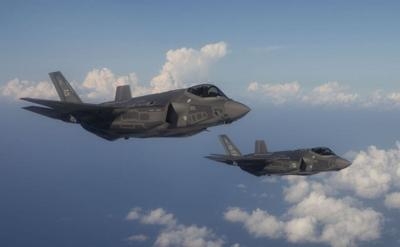Fri, Dec 20, 2013
Non-Profit Research Company Rand Corp. Releases Study Of The JSF Program
A study released this week by the non-profit Rand Corporation indicates that building one airplane to serve three military branches will not save money over building separate airplanes for the Air Force, Navy, and Marine Corps. The study says rather than saving money, it's likely to be more expensive.

Bloomberg News reports that the Rand research institution questions the Pentagon's fundamental assumptions about the F-35, analyzing its estimated $1.5 trillion "life-cycle cost" which includes acquisition and long-term fleet support. The report indicates that "under none of the plausible conditions we analyzed" did the airplane have a lower life cycle cost estimate.
Lorriane Martin, general manager of the F-35 program, admitted to reporters in a briefing last week that the airplane had seen some "challenges, but I would tell you, 'Come look at us today.'"
She said the per-aircraft costs are coming down as the company meets delivery and capability commitments and flight testing milestones.
The initial goal was for the F-35 to have 80 percent common airframe components across the three variants. Bloomberg reports that by 2008, that estimate varied to between 27 percent and 43 percent as challenges in development were addressed and prime contractor Lockheed Martin looked for weight savings on the airplane.
Rand said that "The tension between maintaining maximum commonality and meeting different service requirements has been difficult to resolve.” The end result is "less common variants, greater technical complexity and risk”, as well as difficulty in “achieving the promised savings.”
The report also points out that because of the one-plane-fits-all approach, Lockheed Martin is now the only prime contractor with an advanced stealth fighter program "for the foreseeable future." The study found that the lack of competition in that arena may lead to less innovation and higher prices.
(Image from file)
More News
Aero Linx: The American Society of Aerospace Medicine Specialists (ASAMS) The Society is a non-profit organization created to serve as a voice for and represent the professional ne>[...]
Class C Service This service provides, in addition to basic radar service, approved separation between IFR and VFR aircraft, and sequencing of VFR aircraft, and sequencing of VFR a>[...]
Have A Story That NEEDS To Be Featured On Aero-News? Here’s How To Submit A Story To Our Team Some of the greatest new stories ANN has ever covered have been submitted by our>[...]
Also: ERAU Uses UAVs, P550 Group 2 UAS, Starship’s Florida Launches, NASA Missions Chopped The Air Force has put out a call to commission a one-to-one copy of the Iranian-des>[...]
Classic Klyde Morris From 11.07.16 (and Remembering Bob...) FMI: www.klydemorris.com>[...]
 ANN's Daily Aero-Linx (08.27.25)
ANN's Daily Aero-Linx (08.27.25) ANN's Daily Aero-Term (08.27.25): Class C Service
ANN's Daily Aero-Term (08.27.25): Class C Service ANN FAQ: Submit a News Story!
ANN FAQ: Submit a News Story! Airborne-NextGen 08.26.25: Iran UAV Knockoffs, X-37B Spaceplane, Army Training
Airborne-NextGen 08.26.25: Iran UAV Knockoffs, X-37B Spaceplane, Army Training Classic Klyde Morris (08.25.25)
Classic Klyde Morris (08.25.25)



